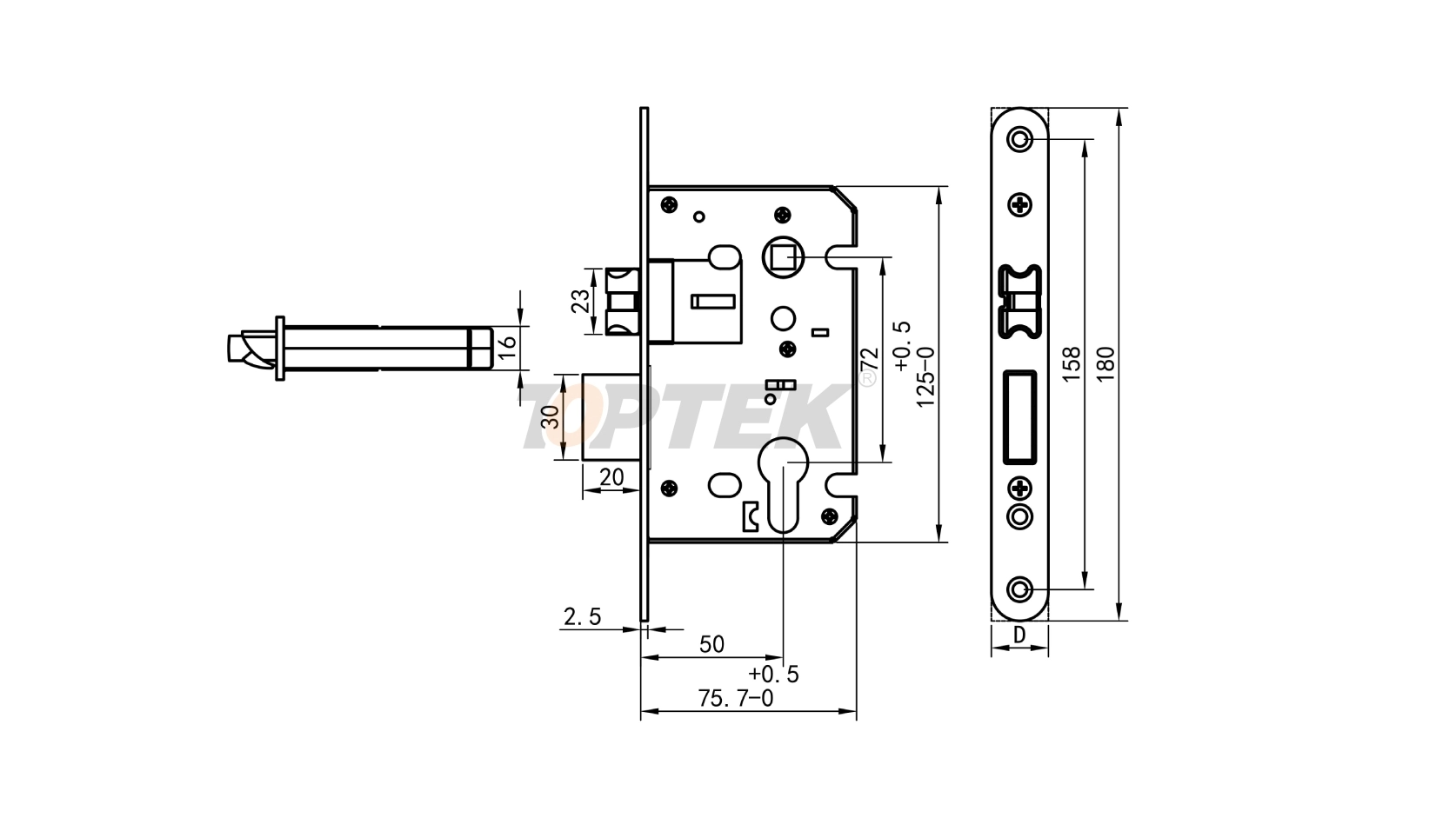When designing an access control system, one critical decision can mean the difference between safety and security during emergencies. Should your electronic locks default to unlocked or locked when power fails? This choice between fail-safe and fail-secure mechanisms affects everything from employee safety to asset protection.
Understanding the fundamental differences between these two locking mechanisms helps you make informed decisions that protect both people and property. This guide explores both systems, their applications, and how to choose the right approach for your specific needs.
Understanding Fail-Safe Locks
Fail-safe locks are designed to unlock automatically when power is lost or the system experiences a failure. The underlying philosophy prioritizes human safety above all else. When an emergency cuts power to the building, these locks allow people to exit freely without requiring keys, codes, or manual intervention.
How Fail-Safe Locks Work
In normal operation, fail-safe locks remain locked through continuous electrical power. The lock mechanism uses electricity to maintain its secured state. When power is interrupted—whether through outages, system failures, or emergency shutdowns—the lock immediately releases, allowing the door to open freely.
This design relies on the principle that people's ability to escape during emergencies takes precedence over maintaining security. Fire suppression systems often integrate with fail-safe locks to ensure automatic unlocking when fire alarms activate.
Key Benefits of Fail-Safe Systems
Life Safety Priority: The primary advantage is unrestricted egress during emergencies. People can evacuate quickly without being trapped by electronic failures.
Code Compliance: Many building codes require fail-safe mechanisms for certain areas, particularly exit routes and public spaces.
Emergency Integration: These systems work seamlessly with fire alarms, emergency lighting, and other safety systems.
Reduced Liability: Building owners face lower liability risks when people can always exit safely during emergencies.
Understanding Fail-Secure Locks
Fail-secure locks take the opposite approach, remaining locked when power fails. Security takes priority over convenience, ensuring that protected areas stay secured even during system failures. These locks require manual keys or backup power systems to open during outages.
How Fail-Secure Locks Work
Fail-secure mechanisms use electrical power to unlock rather than lock. Under normal conditions, the system provides power to disengage the lock when authorized access occurs. When power fails, the mechanical locking mechanism engages automatically, keeping the door secured.
This design assumes that maintaining security during system failures is more important than convenience. Manual override systems, typically involving physical keys, provide necessary access during emergencies.
Key Benefits of Fail-Secure Systems
Asset Protection: Valuable equipment, sensitive documents, and restricted areas remain protected during power outages.
Consistent Security: Security levels don't decrease when electrical systems fail.
Deterrent Effect: The knowledge that locks remain engaged during failures can deter opportunistic security breaches.
Reduced Vulnerability: Power outages don't create security gaps that could be exploited.
Comparing Fail-Safe and Fail-Secure Systems
Safety Considerations
Fail-safe systems excel in protecting human life by ensuring people can always exit during emergencies. This makes them essential for areas where people might be trapped during power failures. Fire codes often mandate fail-safe mechanisms in public spaces, schools, and healthcare facilities.
Fail-secure systems create potential safety risks if people cannot exit during emergencies. However, they're appropriate for areas where security threats outweigh these concerns, such as high-security facilities or restricted access zones.
Security Implications
The security implications differ significantly between these systems. Fail-safe locks create temporary security vulnerabilities during power outages, potentially allowing unauthorized access to sensitive areas. This makes them unsuitable for high-security applications where asset protection is paramount.
Fail-secure systems maintain security during power failures but may require additional planning for emergency access. Manual override systems and backup power solutions help address these challenges.
Cost Considerations
Initial installation costs are similar for both systems, but operational costs can differ. Fail-safe systems may require more frequent testing to ensure proper emergency operation. Fail-secure systems might need backup power systems or manual override procedures that add complexity and cost.
Maintenance requirements vary based on the specific mechanisms used. Both systems require regular testing and maintenance to ensure proper operation during emergencies.

Applications and Use Cases
When to Choose Fail-Safe Systems
Public Buildings: Schools, hospitals, retail stores, and office buildings typically require fail-safe mechanisms for exit doors to ensure safe evacuation.
High-Occupancy Areas: Spaces where many people gather need unrestricted exit capabilities during emergencies.
Fire-Rated Assemblies: Areas with fire separation requirements often mandate fail-safe locks to prevent people from being trapped during fires.
ADA Compliance: Buildings serving people with disabilities may require fail-safe systems to ensure everyone can evacuate safely.
When to Choose Fail-Secure Systems
Data Centers: Facilities housing sensitive electronic equipment need security that doesn't fail during power outages.
Financial Institutions: Banks, credit unions, and investment firms require consistent security for vaults and sensitive areas.
Research Facilities: Laboratories and research centers with valuable equipment or confidential information benefit from fail-secure systems.
Government Buildings: Certain government facilities require security that remains intact during power failures.
Storage Areas: Facilities storing valuable inventory or sensitive materials need security that doesn't depend on electrical power.
Hybrid Approaches and Solutions
Many modern access control systems combine both approaches to balance safety and security needs. These hybrid systems use different locking mechanisms for different areas within the same building.
Zone-Based Systems
Large facilities often implement zone-based approaches where public areas use fail-safe locks while restricted areas use fail-secure mechanisms. This allows safe evacuation from public spaces while maintaining security for sensitive areas.
Time-Based Switching
Some systems automatically switch between fail-safe and fail-secure modes based on time of day or occupancy levels. During business hours with high occupancy, the system might operate in fail-safe mode. After hours, it switches to fail-secure mode for enhanced security.
Emergency Override Systems
Advanced systems include emergency override capabilities that can switch fail-secure locks to fail-safe mode during specific emergency conditions. Fire alarm integration, for example, might temporarily unlock all doors to facilitate evacuation.
Code Compliance and Regulations
Building Codes
Local building codes often specify which locking mechanisms are required for different areas. Exit doors in public buildings typically must use fail-safe systems to ensure safe evacuation. Understanding these requirements is essential for compliance.
Fire Codes
Fire safety regulations frequently mandate fail-safe mechanisms for exit routes. These codes prioritize life safety and require that people can always exit buildings during fire emergencies.
ADA Requirements
The Americans with Disabilities Act includes provisions affecting lock selection. Fail-safe systems may be required to ensure people with disabilities can evacuate safely during emergencies.
Industry Standards
Different industries have specific standards that affect lock selection. Healthcare facilities, educational institutions, and government buildings may have unique requirements that influence the choice between fail-safe and fail-secure systems.
Implementation Best Practices
Risk Assessment
Begin with a thorough risk assessment that evaluates both safety and security needs. Consider factors like occupancy levels, asset values, threat assessments, and regulatory requirements.
Professional Consultation
Work with qualified security professionals and code enforcement officials to ensure proper system selection and installation. Their expertise helps navigate complex regulations and technical requirements.
Testing and Maintenance
Implement regular testing procedures to ensure both fail-safe and fail-secure systems operate properly during emergencies. Document all testing and maintenance activities for compliance purposes.
Training and Procedures
Develop clear procedures for different emergency scenarios and train staff on proper responses. This is particularly important for facilities using fail-secure systems where manual intervention may be required.
Making the Right Choice for Your Facility
Selecting between fail-safe and fail-secure locks requires careful consideration of your specific needs, regulations, and risk tolerance. Most facilities benefit from a combination approach that uses fail-safe mechanisms for public areas and exit routes while employing fail-secure systems for sensitive or high-value areas.
The decision impacts not only daily operations but also emergency response capabilities and compliance with various regulations. Professional guidance from security experts and code officials ensures your access control system meets all requirements while effectively balancing safety and security needs.
Consider your facility's unique characteristics, including occupancy patterns, asset values, regulatory requirements, and potential threats. The right choice provides effective security during normal operations while ensuring appropriate responses during emergencies.
Access Control System
access control commercial lock
Access Control Locks
English
العربية
Français
Русский
Español
Português
Deutsch
italiano
日本語
한국어
Nederlands
Tiếng Việt
ไทย
Polski
Türkçe
አማርኛ
ພາສາລາວ
ភាសាខ្មែរ
Bahasa Melayu
ဗမာစာ
தமிழ்
Filipino
Bahasa Indonesia
magyar
Română
Čeština
Монгол
қазақ
Српски
हिन्दी
فارسی
Kiswahili
Slovenčina
Slovenščina
Norsk
Svenska
українська
Ελληνικά
Suomi
Հայերեն
עברית
Latine
Dansk
اردو
Shqip
বাংলা
Hrvatski
Afrikaans
Gaeilge
Eesti keel
Māori
සිංහල
नेपाली
Oʻzbekcha
latviešu
অসমীয়া
Aymara
Azərbaycan dili
Bamanankan
Euskara
Беларуская мова
भोजपुरी
Bosanski
Български
Català
Cebuano
Corsu
ދިވެހި
डोग्रिड ने दी
Esperanto
Eʋegbe
Frysk
Galego
ქართული
guarani
ગુજરાતી
Kreyòl ayisyen
Hausa
ʻŌlelo Hawaiʻi
Hmoob
íslenska
Igbo
Ilocano
Basa Jawa
ಕನ್ನಡ
Kinyarwanda
गोंगेन हें नांव
Krio we dɛn kɔl Krio
Kurdî
Kurdî
Кыргызча
Lingala
Lietuvių
Oluganda
Lëtzebuergesch
Македонски
मैथिली
Malagasy
മലയാളം
Malti
मराठी
ꯃꯦꯇꯥꯏ (ꯃꯅꯤꯄꯨꯔꯤ) ꯴.
Mizo tawng
Chichewa
ଓଡ଼ିଆ
Afaan Oromoo
پښتو
ਪੰਜਾਬੀ
Runasimi
Gagana Samoa
संस्कृत
Gaelo Albannach
Sepeti
Sesotho
chiShona
سنڌي
Soomaali
Basa Sunda
Wikang Tagalog
Тоҷикӣ
Татарча
తెలుగు
ትግንያውያን
Xitsonga
Türkmençe
संस्कृत
ئۇيغۇرچە
Cymraeg
isiXhosa
ייִדיש
Yorùbá
isiZulu






































